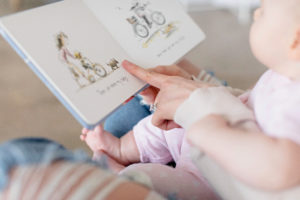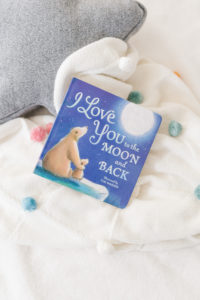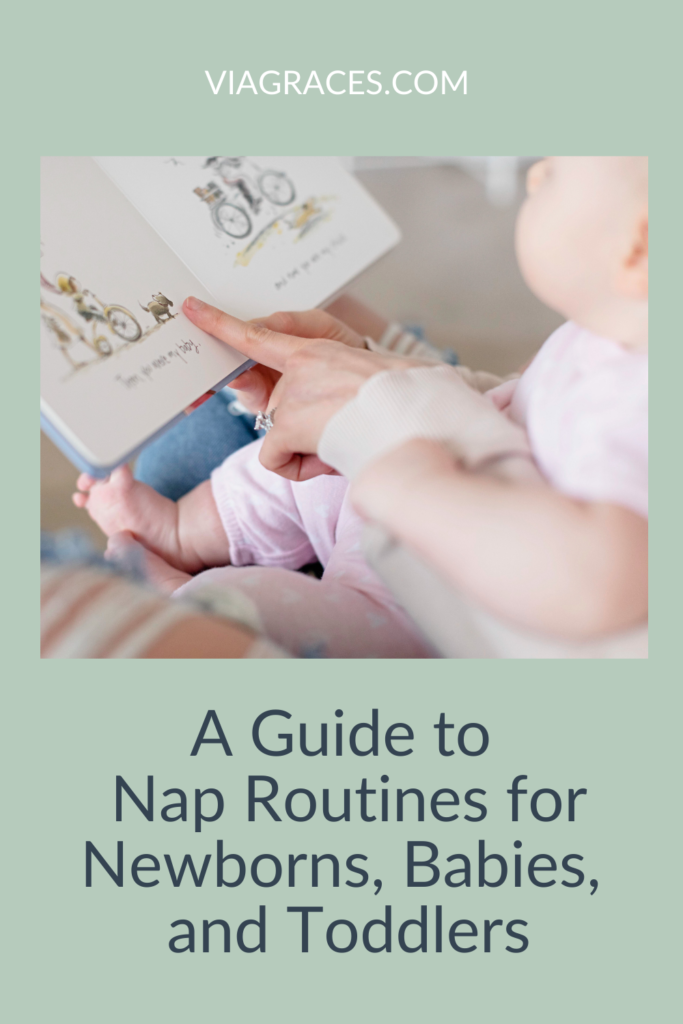If you’ve done some digging into baby and toddler sleep, even just a little bit, you’ve certainly read about bedtime routines. Consistent bedtime routines are SO important, to help our littles ones mentally register that sleep is coming and for their physical bodies to continue preparing for a long stretch of sleep (think melatonin!).
While daytime sleep is certainly different than night time sleep, and nap routines are much shorter than bedtime routines, nap routines are still incredibly important!

So in this blog post, I’m going to walk through:
- Why nap routines are so important
- Where to do your baby and toddler’s nap routine
- Examples of nap routines for newborns, babies, and toddlers
And more!
The Importance of a Consistent Nap Routine
Similar to bedtime routines, nap time routines are important to help your baby or toddler recognize that it’s time for sleep.
To go right from tummy time on the floor to lying on their back in a bassinet is a big difference! To go from listening to music and shaking a maraca to all of a sudden being in a crib is huge. Or to be engrossed in a puzzle and all of a sudden being in your crib with the lights out is a stark contrast.
In order to help our kids fall asleep with confidence, they need to know what’s coming. For this reason, having a consistent nap routine is key!
Where Should Nap Routines Take Place?
Aim to have your baby and toddler’s entire nap routine happen in the room where they sleep, whether that’s in your room as you room share, or in the nursery. Doing the routine in the space where they will be sleeping is a helpful clue to their mind that sleep is, in fact, coming.
For toddler’s, especially, being removed from all the fun toys and activities they were just playing with is helping to prevent further trouble transitioning!
Newborn Nap Routines
Nap routines with a newborn?? Yep! It’s never too early to establish nap and bedtime routines.
When it comes to newborn naps, they are going to happen anywhere and everywhere – on you, in the car, in the bassinet, the carrier, etc. And that’s great! Newborns take far too many naps to all happen in their crib, plus we want to soak up lots of those sweet snuggles. So a nap time routine for a newborn won’t be as consistent as a baby’s or toddler’s, because newborn naps happen all over the place.
That being said, if you are going to lay your newborn in their bassinet or crib for a nap, whether you rock them to sleep or are practicing helping them fall asleep starting awake, having a nap routine is helpful to establish.
Example of a newborn nap routine:
- Change diaper
- Swaddle
- Sing
If you plan to simply snuggle your baby or know you’ll be out and about, you certainly don’t need to worry about such a structured nap routine! I do, however, like having something like a song, as it’s a portable piece of the nap routine. So as you’re cuddled up on the couch or going for a walk, you can sing that nap song in your newborn’s ear to both help establish that that song is connected to sleep, and to help them connect the fact that it’s time to sleep.
Baby Nap Routines
Similar to newborns, some baby naps are still going to happen on the go, but ideally more and more would happen in their crib. So having a consistent nap routine is especially important at this age.
Around 3 or 4 months old, when babies are starting to really discover their hands and interact more with objects around them, I love adding a story into their nap routine. You can certainly add one sooner, but this is the age I find they start paying attention to them. Using high contrast books, touch and feel books, feelings books, etc., are all great ways to engage your baby in their nap routine.
Example of a baby nap routine:
- Change diaper
- Sleep sack
- Read a book
- Sing

Toddler Nap Time Routines
Nap routines are important at any age, but if I had to choose which was MOST important, I would say it’s for our wonderful toddlers. Routines, in general, are key for toddlers, which means routines around sleep (nap time and bedtime) are crucial.
Example of a toddler nap routine:
- Change diaper/go potty
- [Sleep sack, if applicable]
- Read one or two books
- Sing
Extra tips for toddlers’ nap time and nap routines:
Aim for nap time to occur right after lunch
As much as you’re able to control it, aim for your toddler’s nap to happen right after lunch, almost as if lunch is the start of the nap time routine. If a toddler eats lunch, has 10 minutes to play, and then it’s nap time, it can make the transition that much harder because they just got engrossed in some activity.
Give them a nap time reminder
If you’re not able to go right from lunch time to nap time, or even if you are, giving your toddler a reminder that nap time is coming is so helpful. Something like, “Now it’s time to wash your hands and take a nap!” Or, “Where do we go when we finish lunch?”
Or if they’re playing: “In 2 more minutes we’re going to potty and read books for nap time.” You could even use a visual timer, like this. Transitioning can be especially challenging for toddlers, so help them get there!
Put them in pajamas (if applicable)
This might sound ridiculous, and I certainly don’t recommend it to all families, but some toddlers benefit from changing into their pajamas before nap time! For those who really struggle to fall asleep, or seem to be fighting nap time more lately but clearly still need one, getting their pajamas on is one more “clue” to their body that it’s time for sleep.
Take their shoes off (if applicable)
If your child attends daycare and is struggling with naps there, this one is for you! Because they are caring for so many kiddos and removing shoes can take up time, some daycares keep toddlers’ shoes on for nap time!
And for some kids, it doesn’t bother them at all – that’s just what they do. But for toddlers who struggle with napping at daycare, ask your provider if they sleep with shoes on, and if they do, ask they that try taking their shoes off for a couple of weeks to see if that makes a difference! Sometimes something so small can make such a difference when it comes to toddler naps.

Feedings and Nap Routines
If your goal is for your baby or toddler to fall asleep independently for naps and bedtime, it’s important that they are not only falling asleep while drinking milk (or with other sleep props, such as rocking or holding your hand), but that milk isn’t in their nap routine at all!
Even if your child isn’t completely falling asleep while nursing or drinking their bottle, they are very likely getting drowsy and relying on that milk to some extent to help them start the process of sleep. And this will likely result in short naps, night wakings, early morning wakings, etc.
So as a general rule of thumb, I recommend families leave at least 15-20 minutes between finishing nursing or bottle feeding and laying your baby or toddler down for a nap. For newborns, I suggest leaving around 10 minutes between finishing that feed and sleep, as their awake windows are much shorter.
If you do currently feed your baby or toddler to sleep and plan on continuing to do so, a consistent nap routine is still helpful for your little one! Having those predictable steps leading up to feeding to sleep will still help them recognize that this is not simply milk time, but it’s milk time intended on ending with sleep.
Conclusion
If you are reading this and have never had a nap time routine with your baby or toddler, that’s okay – start NOW! It’s never too late to establish a nap routine or even change your current nap routine.
Daily routines help kids and adults, alike, prepare for what’s coming next in their day. And sleep is something that will absolutely happen every day…so establish a consistent nap routine for your newborn and continue it on through their baby and toddler years!
With Grace,
Lauren
